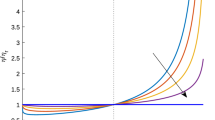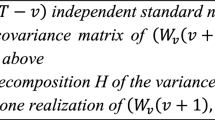Abstract
Based on the matrix-analytic approach to fluid flows initiated by Ramaswami, we develop an efficient time dependent analysis for a general Markov modulated fluid flow model with a finite buffer and an arbitrary initial fluid level at time 0. We also apply this to an insurance risk model with a dividend barrier and a general Markovian arrival process of claims with possible dependencies in successive inter-claim intervals and in claim sizes. We demonstrate the implementability and accuracy of our algorithms through a set of numerical examples that could also serve as test cases for comparing other solution approaches.
Similar content being viewed by others
References
Abate J, Whitt W. The Fourier-series method for inverting transforms of probability distributions. Queueing Syst 1992;10:5–88.
Abate J, Whitt W. Numerical inversion of Laplace transforms of probability distributions. ORSA J Comput 1995;7(1):36–43.
Ahn S, Ramaswami V. Fluid flow models and queues—A connection by stochastic coupling. Stoch Models 2003;19(3):325–48.
Ahn S, Ramaswami V. Transient analysis of fluid flow models via stochastic coupling to a queue. Stoch Models 2004;20(1):71–101.
Ahn S, Ramaswami V. Efficient algorithms for transient analysis of stochastic fluid flow models. J Appl Probab 2005;42(2):531–49.
Ahn S, Ramaswami V. Transient analysis of fluid flow models via elementary level crossing arguments. Stoch Models 2006;22(1):129–47.
Ahn S, Jeon J, Ramaswami V. Steady state analysis of finite fluid flow models using finite QBDs. QUESTA 2005;49:223–59.
Akar N, Sohraby K. Infinite- and finite-buffer Markov fluid queues: a unified analysis. J Appl Probab 2004;41:557–69.
Albrecher H, Boxma O. On the discounted penalty function in a Markov-dependent risk model. Insur Math Econ 2005;37(3):650–72.
Albrecher H, Kainhofer R. Risk theory with a nonlinear dividend barrier. Computing 2002;68:289–311.
Anick D, Mitra D, Sondhi MM. Stochastic theory of data handling system with multiple sources. Bell Syst Tech J 1982;61:1871–94.
Asmussen S. Stationary distributions via first passage times. In: Dshalalow JH, editor. Advances in queueing: theory, methods, and open problems. Boca Raton: CRC Press; 1995. p. 79–102.
Asmussen S. Stationary distributions for fluid flow models with or without Brownian noise. Stoch Models 1995;11:1–20.
Asmussen S. Matrix-analytic models and their analysis. Scand J Stat 2000;(2):193–226.
Asmussen S, Avram F, Usabel M. Erlangian approximations for finite time ruin probabilities. ASTIN Bull 2002;32:267–81.
Badescu A, Breuer L, Da Silva Soares A, Latouche G, Remiche MA, Stanford D. Risk processes analyzed as fluid queues. Scand Actuar J 2005;2:127–41.
Badescu A, Breuer L, Drekic S, Latouche G, Stanford D. The surplus prior to ruin and the deficit at ruin for a correlated risk process. Scand Actuar J 2005;6:433–45.
Barlow MT, Rogers LCG, Williams D. Wiener-Hopf factorization for matrices. In: Seminaire de probabilites XIV. Lecture notes in math. vol. 784. Berlin: Springer; 1980. p. 324–31.
Bean NG, O’Reilly M, Taylor PG. Hitting probabilities and hitting times for stochastic fluid flows. Stoch Proc Appl 2005;115(9):1530–56.
Bühlmann H. Mathematical methods in risk theory. New York: Springer; 1970.
da Silva Soares A. Fluid queues—building upon the analogy with QBD processes. Doctoral Dissertation, Universite Libre de Bruxelles, Belgium; 2005.
da Silva Soares A, Latouche G. Matrix-analytic methods for fluid queues with finite buffers. Perform Eval 2006;63:295–314.
De Finetti B. Su un’impostazione alternativa dell teoria collectiva del rischio. Trans XV Int Congr Actuar 1957;2:433–43.
Gerber HU. An introduction to mathematical risk theory. S.S. Huebner Foundation. Philadelphia: University of Pennsylvania; 1979.
Gerber HU. On the probability of ruin in the presence of a linear dividend barrier. Scand Actuar J 1981;105–15.
Gerber HU, Shiu ESW. On the time value of ruin. North Am Actuar J 1998;2(1):48–78.
Gerber HU, Shiu ESW. The time value of ruin in a Sparre Andersen model. North Am Actuar J 2005;9(2):49–84.
Høojgard, B. Optimal dynamic premium control in non-life insurance: maximizing the dividend payouts. Scand Actuar J 2002;4:225–45.
Kobayashi H, Ren Q. A mathematical theory for transient analysis of communication networks. IEICE Trans Commun 1992;12:1266–76.
Latouche G, Ramaswami V. Introduction to matrix analytic methods in stochastic modeling. Philadelphia: SIAM and ASA; 1999.
Li S, Garrido J. On a class of renewal risk models with a constant dividend barrier. Insur Math Econ 2004;35:691–701.
Li S, Garrido J. On a general class of renewal risk process: analysis of the Gerber-Shiu function. Adv Appl Probab 2005;37(3):836–56.
Lin XS, Willmot GE, Drekic S. The classical risk model with a constant dividend barrier: analysis of the Gerber-Shiu discounted penalty function. Insur Math Econ 2003;33:551–66.
Neuts MF. Matrix-geometric solutions in stochastic models—an algorithmic approach. Baltimore: The Johns Hopkins University Press; 1981.
Paulsen J, Gjessing H. Optimal choice of dividend barriers for a risk process with stochastic returns on investments. Insur Math Econ 1997;20:19–44.
Ramaswami V. Matrix analytic methods for stochastic fluid flows. In: Smith D, Key P, editors. Teletraffic engineering in a competitive world—proc. of the 16th international teletraffic congress. New York: Elsevier; 1999. p. 1019–30.
Ramaswami V. Passage times in fluid models with application to risk processes. Methodol Comput Appl Prob 2006;8:497–515.
Ramaswami V, Poole D, Ahn S, Byers S, Kaplan AE. Ensuring access to emergency services in the presence of long Internet dial up calls. Interfaces 2005;35(5):411–22.
Remiche MA. Compliance of the token-bucket model with Markovian traffic. Stoch Models 2005;21:615–30.
Rogers LCG. Fluid models in queueing theory and Wiener-Hopf factorization of Markov chains. Ann Appl Probab 1994;4(2):390–413.
Scheinhardt W. Markov-modulated and feedback fluid queues. Thesis, University of Twente, Enscheide, The Netherlands; 1998.
Segerdahl C. On some distributions in time connected with the collective theory of risk. Scand Actuar J 1970;167–92.
Sericola B. Transient analysis of stochastic fluid models. Perform Eval 1998;32:245–63.
Thorin O, Wikstad N. Numerical evaluation of ruin probabilities for a finite period. Astin Bull 1973;7:137–53.
Tijms HC. Stochastic modelling and analysis: a computational approach. New York: Wiley; 1986.
Author information
Authors and Affiliations
Corresponding author
Rights and permissions
About this article
Cite this article
Ahn, S., Badescu, A.L. & Ramaswami, V. Time dependent analysis of finite buffer fluid flows and risk models with a dividend barrier. Queueing Syst 55, 207–222 (2007). https://doi.org/10.1007/s11134-007-9017-x
Received:
Revised:
Published:
Issue Date:
DOI: https://doi.org/10.1007/s11134-007-9017-x




